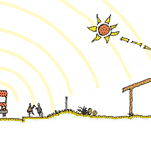- Home
- Site Analysis
- Site Use
- Passive Design
- Water
- Material Use
- Energy
- Wet Areas
- Health and Safety
- Other Resources
Passive Design
Designing the building and the spaces within it to benefit from natural light, ventilation and even temperatures.
Fences, walls and earth mounds as sound barriers
High-mass fences or walls, or earth mounds, can reduce external noise as long as the source is lower than or level with the barrier.
Barriers will not reduce noise that originates from above the barrier.
The ideal house orientation may not be possible if there is a significant source of noise from the north side. Careful design can minimise the disturbance caused by the noise, while still allowing sun into the house:
- Brick/concrete walls: A 2.0 m high brick or concrete masonry wall is an effective barrier against direct noise, but some noise will pass over the barrier.
- Earth mounds: A similar effect may be achieved by building an earth mound to a similar height.
- Timber fences: A 2.0 m high timber fence with solid palings (no gaps), sheet material or a combination of both will create an effective noise barrier. The palings or sheet material should have a minimum mass of 12 kilograms per square metre. The fence must have no gaps or cracks or no spaces under the fence at the ground level. Some noise may pass over the barrier. The effectiveness of the barrier can be improved by building the fence on top of a bank or rise. The maximum height of fencing is governed by requirements in the district plan, which can be obtained from the local council.
- Trees and shrubs: These are not effective as an acoustic barrier but they provide a visual barrier and may have psychological benefits.


